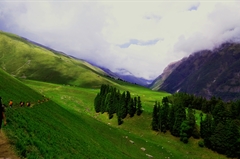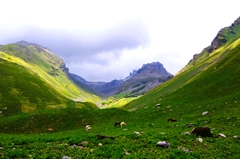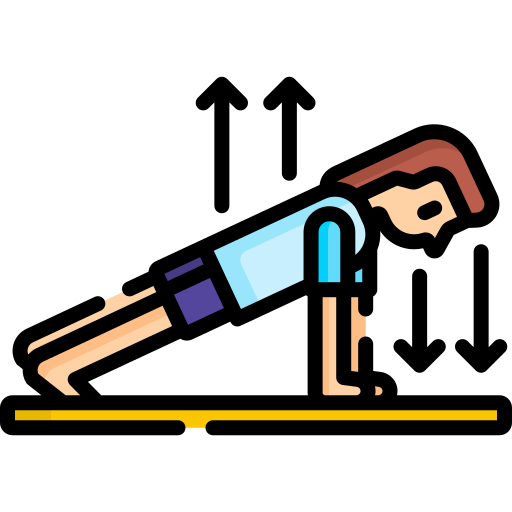Buran Ghati Trek
Trek with the most thrilling rappelling experience
Available Batches



Brief Description
Brief Itinerary
Detailed Itinerary
Day 1
Shimla to Janglik (2804 M)
Distance: 150 kms
Duration: 8-9 hours
Assemble in Shimla early morning (by 8 AM) and board your vehicles for the drive to Janglik. We drive along Pabbar River through the mixed forest. Villages with beautiful Himachal homes & step fields of wheat adorn the sides of the road. From Chirgaon onwards the road condition is bad. The road crosses the Pabbar river at Tonglu & then climbs to Janglik. The entire drive takes about 8-9 hours.
Day 2
Janglik to Dayara (3366 M) (Click to View GPS data)
Distance: 7.7 kms
Duration: 5-6 hours
We cross through the village homes. Within half an hour we are past the village. The trail is steep initially. After you have climbed considerably, halt to get a good view of the valley. Spot Janglik, Tonglu & other nearby villages from here. The trail enters the forest and turns gradual. Walking under the shade of trees after a steep climb is a welcome change. The views along the trail are captivating. The trail enters & comes out of the forest a couple of times till we finally arrive at our destination for the day. Overnight camping.
Day 3
Dayara to Litham (3533 M) (Click to View GPS data)
Distance: 5.6 kms
Duration: 3-4 hours
Get up early to catch the view of golden rays of sun falling on the grass in the meadow. Enjoy the view with a hot cup of tea. Today's trail majorly constitutes of forests, meadows & gushing streams of water. We walk through the meadows towards the Gunas Pass. After we cross a steam, the view of the Dhauladhar range is captivating. A few minutes after we enter the forest of Bhoj trees (Silver Birch). After a while, we come across another stream. Cross it & get your first view of Litham. We would walk in a gorgeous meadow again. Across the meadow, we cross the Chandranahan Stream and arrive at our campsite for the day. Litham is a beautiful campsite. Notice the Chandranahan waterfalls beyond which lies the famous Chandranahan Lake. Buran Ghati lies behind the mountain in front of us. Get ready for a great adventure starting tomorrow.
Day 4
Litham to Chandranahan Lakes (4029 M) & back to Litham, (Click to View GPS data)
Distance: 8.3 kms
Duration: 5-6 hours
The Chandranahan is a glacial lake that is fed by snow melts of mountains that surround it. It is a small lake, However getting to it is an exciting experience and extremely fulfilling. We cross the stream that we saw just before the Litham campsite. We continue upstream on the trail to the top of the ridge. Then we walk towards the snout of the waterfall. After spending some time at the lake we turn back to the campsite. This short excursion will help you acclimatize for the trek ahead.
Day 5
Litham to Dunda (4025 M), (Click to View GPS data)
Distance: 4.3 kms
Duration: 3-4 hours
Continue north-east along the Pabbar River which originates from the slopes of the Buran Ghati. Pass through Khubrini Thach and leaving the tree line behind climb steeply through boulders to enter Dunda Thach, located at the foot of the pass.
Day 6
Dunda to Manerang (3338 M) via Buran Pass (4575 M), (Click to View GPS data)
Distance: 8 kms
Duration: 9-10 hours
In post-monsoon season the climb to the pass is easier due to lesser or no snow. From Dunda camp walk on the ridge through the boulders. From the base of the Buran pass, the climb to the top takes about one hour. Take halt at the pass & absorb the mesmerizing view. The path on the other side of the Buran pass is a steep drop. Use of rope is highly recommended here. The steep drop gives way to a snow field from where it is easy to slide down. Decent is fast & we lose altitude quickly. We will set camp next to the river and cross it a little further down the valley the next morning.
Day 7
Manerang to Barua (2510 M), (Click to View GPS data) Onward to Shimla
Distance: 5.7 kms + 250 kms drive
Duration: 2-3 hours
Today, we descend down the valley to a stream that we hop through. The trail is well marked from river campsite. Take the lower trail descending into the valley. The trail passes through grasslands & forest of pine trees. Arrive at kahrcham by the afternoon and board your vehicles for the return journey. The vehicles will drop you in Shimla. The Buran Ghati trek ends here.
Day 8
Buffer Day
This will only get used if unexpected and unforeseeable conditions present themselves at the last minute preventing us from reaching our destination as planned. You are advised to keep a buffer day in your travel plan. If the buffer day is used, you have to pay Rs. 2,500 per day (INR). The amount will be collected by the Trek Leader.
What's Included
- Food as per menu on the trek
- Forest Permits/Camping Charges, if any (upto the amount charged for Indian nationals)
- Tents, Sleeping bags, Sleeping mats
- Safety Equipment includes static rescue rope, seat harness, carabiners, pulleys
- Trek guide, cook, helpers, and porters for carrying common supplies
- Mountaineering course certified Trek Leader with Wilderness Emergency Responder & Rescue. course from NIM Uttarkashi
What's Not Included
- Portage of personal bags during the trek
- Cost of any kind of Travel Insurance.
- Any Expense of personal nature.
- Any Expense not specified in the inclusions list.
- Meals during road journeys
Are you Eligible for this Adventure?
BRS Level Required
This makes it mandatory for you to have high-altitude experience of preferably multiple treks marked at level 5 on the BRS. The altitude, the terrain and the nature of the climb demand a certain level of skill and a need for you to be aware of how your body reacts to the various features of high altitude environment.
If you do not know what level of BRS trek would suit you best, worry not! Fill out this Form:
we will send you a progression chart to help you comfortably get out of your comfort zone in order to level up and ultimately reach your highest potential in the big, bad world of outdoor adventure.
Packing List
This is a list of essential items for individuals doing the trek with Bikat Adventures. This list contains only those items which the participants are required to bring with them. The list excludes those items which are provided by Bikat Adventures on the trek. We have divided the items into five categories. All the items in the list are essential except for those marked as optional.
Trekking Gear
- Ruck sack bag with rain cover. Qty -1
- Day Pack Bag - Recommended for treks with summit day
- Head Torch with spare Batteries. Qty -1
- U V protection sunglasses. Qty -1 Here is how you can choose the best sunglasses for trekking.
- Water Bottles: 2 bottles of 1 liter each
Footwear
- Non-skid, deep treaded, high-ankle trekking shoes Qty -1
- Pair of light weight Slipper/Sandals Qty -1
Clothing
- Quick Dry Warm lower or Track Pants. Qty - 2
- Full sleeves T-shirts/ Sweatshirts. 1 for every 2 days of trekking
- Pair of thick woolen socks. 1 pair for every two days of trekking
- Thermal Body warmer Upper & Lower. Qty-1
- Undergarments. Qty - 1 for every day of trekking
- Warm jacket closed at wrist & neck .Qty-1
- Full sleeves sweater. Qty -1
- Rain wear ( Jacket & Pants ) . Qty-1
- Pair of waterproof, warm gloves. Qty-1
- Woolen cap. Qty-1
- Sun shielding Hat. Qty -1
Toiletries
- Personal toiletries kit (Small Towel, Toilet paper, paper soap, Bar soap, toothbrush, toothpaste, cold cream, etc.)
- Sun screen lotion small pack. Qty -1 Here is your Sun Protection 101 to stay safe in the bright sunny outdoors.
- Lip Balm small pack. Qty-1
Utensils
- Small size, Light weight & Leak proof lunch box. Qty-1
- Plate. Qty- 1
- Spoon.Qty-1
- Tea/Coffee (plastic) Mug.Qty-1
Miscellaneous
- Camera (Optional)
- Carry your medicines in plenty in case you have any specific ailment. Consult your doctor before joining the trek.
- Dry fruits, Nuts, Chocolate bars (Optional)
Frequently Asked Questions
Why Bikat?
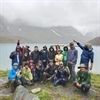

Small Group Size
Our batch sizes are capped at 15 for smaller treks with the trek leader and trekker ratio of 1:8. This ratio, in our years of experience, has proven to deliver the best trekking experience for individuals as well as groups. Capping the size of the group ensures individual attention to each trekker so that no signs of distress or need during the trek go unnoticed. It also helps to form a more cohesive cohort with better group energy which helps define the rhythm and pace of days on the trek. As you go higher up on the BRS scale, since the stakes are higher, expeditions have an even smaller group size with the ratio of expedition leader to climber set at 1:2.


Qualified Trek Leaders
We follow a rigorous regime of hiring and training our experts in the field. Each trek leader is a certified mountaineer with years of experience in the field. In addition to their qualification, they also go through practical and situational training to tackle any and all kinds of sudden conditions that may present themselves on the ground. Being unpredictable is the core nature of the mountains but being ready for any circumstance as best as possible is a controllable asset that we try to nurture. Our field experts are also trained in basic medicine and first-aid response. Watch: Forerunners - The Making of A Trek Leader At Bikat Adventures


Guided Progression
Since Bikat Adventures is a learning-based organization, we help you climb up the ladder of difficulty within the sphere of outdoor adventure systematically. Our on-ground training modules are designed to handhold you through the upskilling process so that you are ready to take on bigger challenges.


Equipment Quality and Check
All the gear used on our treks and expeditions is tried and tested, maintained for good quality, and is overall top-notch in quality and condition. We are continually looking to obtain the best of everything there is in the market so as to ensure optimum safety.


Support Systems
Along with the staff you see on-ground, we have a team of superheroes working in the background to give you the best experience possible. Our background team also comprises local staff from each area who know the region best. Having local support helps with studying the area, pre-planning, execution, and in receiving timely support in case of emergencies in these remote locations.


Communication
Our on-field staff is in constant contact with our teams based in primary locations so as to eliminate any avoidable delay in reaching additional help and support when required. We try to use the best tools for communication available, including satellite phones, in regions where they are not restricted.
What our customers Say
Cancellation Policy
Cash refund
Cancellations up to 60 days prior to departure date
Between 60 days upto 30 days prior to departure date
Between 30 days upto 10 days prior to departure date
Less than 10 days prior to departure date
Voucher refund
Cancellations up to 30 days prior to departure date
Between 30 days upto 15 days prior to departure date
Between 15 days upto 10 days prior to departure date
Less 10 days prior to departure date
- Cash refund is applicable only in case of bookings made without using any promotional offer code or Cancellation Vouchers or Discounts
- This is only a brief of cancellation terms. For finer details please refer Detailed Cancellation Policy.
Blog Posts
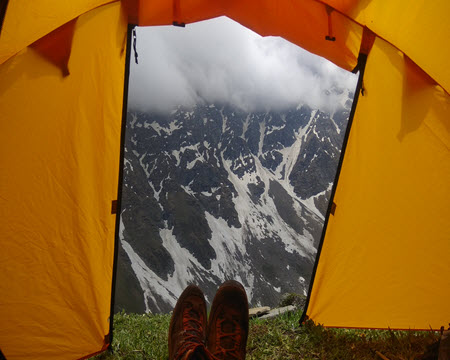



Similar Adventures

Rupin Pass Trek
The Grandest Cross-Over Trek of India
Himachal
7 Days
BRS 4
4632 m

Pin Bhaba Pass Trek
Your gateway to two contrasting worlds - Bhaba & Pin
Himachal
7 Days
BRS 5
4915 m
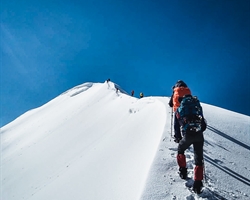
Bali Pass Trek
A badass trek for seasoned trekkers
Uttarakhand
9 Days
BRS 5
4950 m

Hampta Pass Trek
An Enchanting Cross-Over from Manali to Spiti
Himachal
5 Days
BRS 4
4200 m

